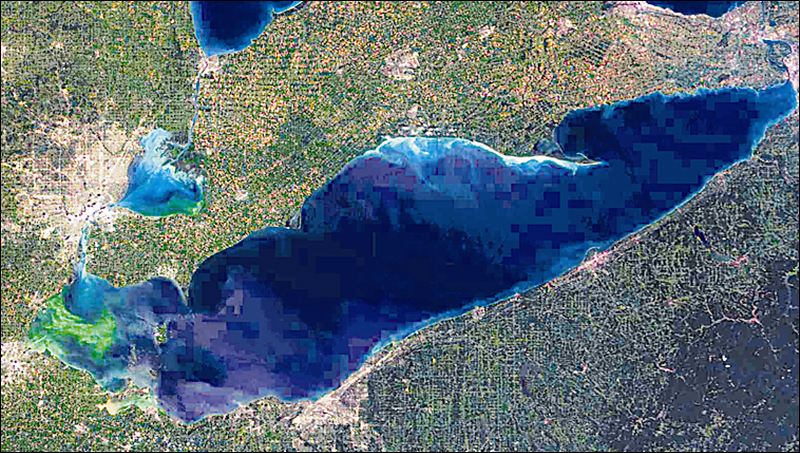Podcast: Play in new window | Download
Subscribe: RSS

A satellite view released by NASA shows a blue-green algae bloom (the green part) taking over western Lake Erie (the blue part). And that's not all.
A legacy of industrial agriculture, energized by climate change, a continent-sized explosion of toxic algae blooms is besieging the freshwater lakes of North America, sickening people, killing animals and wrecking tourist- and recreation-based local economies. Although each eruption is big news in local papers, the unprecedented extent and severity of the epidemic has drawn no attention from national news media or political figurines.
The bad actor is a micro-organism known variously as pond scum, green slime, blue-green algae and cyanobacteria. It is an ancient life form, one that is thought to have played a key role in oxygenating our infant planet, and it is found everywhere, especially in streams and lakes. Although it is a bacteria, it gets its energy from photosynthesis. Normally it is benign, but when stimulated by synthetic fertilizers washing off mismanaged fields or city lawns, in waters heated by above-normal temperatures and concentrated by evaporation in prolonged drought, the algae population explodes.
If these euphemistically labelled “blooms” were simply a matter of clogging a lake with hideous green scum, they would be bad enough. But certain cyanobacteria, such as microcystis algae, produce toxins, and when the population explodes, so does the concentration of toxins. They are neurotoxins, that affect the nervous system, and can cause numbness, tingling and dizziness that can lead to difficulty in breathing, heart problems, skin irritation, weakness, diarrhea, nausea, cramps and/or fainting, all or any of which require immediate medical attention. Children and pets are particularly susceptible, and significant exposure will kill them.
Obviously, you do not want to touch or drink water from a lake or stream that has an algae bloom in it. The toxins cannot be removed from the water by boiling, filtering or treating the water with camping-style purifiers. A municipal system can get the stuff out if it knows what it’s doing and can afford the high cost. But you also want to think twice about eating fish from algae-infested water, and if you do, you must remove all fat, skin and organs — where the toxins collect — before cooking. Just boating on toxic waters is problematic because if you kick up spray and inhale it — call 911. One lake with an algae advisory in place pleaded with people to come to the lake anyway and enjoy, um, birdwatching. Oh, and hiking, as long as you stay away from the water.
How widespread is the problem? Here is a brief survey of last week’s developments:
- In California, county officials in Lake County announced they are going to try vacuum dredging to deal with algae blooms on Clear Lake. Many resort owners in the area have canceled reservations all summer because of the algae conditions, and although they have no idea whether dredging the stuff, drying it and landfilling it will prove effective, they are going ahead in desperation.
- Oregon issued a health advisory prompted by high algae levels found in Diamond Lake, located seven miles north of Crater Lake National Park on Friday.
- The Ohio Department of Health is looking into a case from Buckeye Lake east of Columbus and a case from Grand Lake St. Marys, between Dayton and Toledo. A warning at Grand Lake St. Marys urges people not to swim in the water. An advisory issued Thursday urges visitors not to ingest water at Lake Hope in Vinton County, where Lake Alma is under the same warning. [I wrote about Grand Lake St. Mary’s back in January: see “Ohio Lake ‘Dying’: Governor Applies Lipstick.”] Ohio is also struggling with a massive bloom in western Lake Erie, a result of massive pollution by synthetic fertilizer (see photo above).
- Oklahoma officials closed a beach at Skiatook Lake, while Oklahoma City’s Water Quality department has found blue-green algae in Lake Hefner, Lake Overholser, Eufaula, Fort Gibson and Keystone lakes.
- Wisconsin health officials around Lake Winnebago are urging people to be cautious after blue-green algae blooms were found on the lake..Also, a huge bloom of toxic microcystis algae in eastern Lake Erie (an annual event since 1995), is so large this year it has been visible from space since at least July 22.
- At Rochester, New York, the U.S. Army Corps of Engineers has declared itself to be “pleased” with the results of a system that removes algae from the waters off Lake Ontario beaches. This leading-edge answer to the problem of massive nutrient pollution by industrial agriculture is to pump algae-laden water away from the beach and out into the lake. The theory would appear to be: out of sight, out of mind. So far, the Corps says, the system has “worked well” in a test at Ontario Beach, which has nevertheless been closed eight times this summer.
- In Maryland near Washington, D.C. officials cautioned Friday against swimming, water skiing or other activities in or on a portion of the Potomac River and one of its tributaries because of a mycrocystis algae bloom.
- In Canada, large algae outbreaks were reported in central Alberta (Pigeon Lake, Ma-Me-O Beach, Wizard Lake and Baptiste Lake), Ontario and New Brunswick.
[For updates on this and other Daily Impact stories, and for short takes on other subjects, check out The Editor’s Log.]